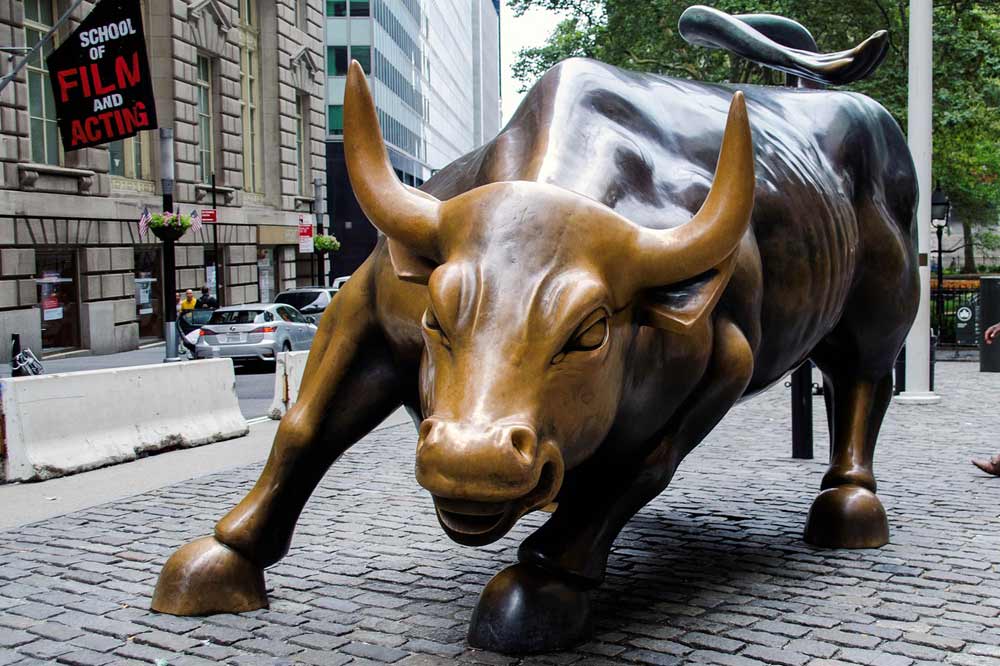Markets run in cycles, which makes it important for investors to pay attention to bull vs bear markets.
They can go through rallies, a short period of the increased stock or crypto value before the value drops below the average. Markets can also undergo corrections, a more than 10% drop in a stock’s value. A correction can last a few hours or even years.
Investors and traders need to gain insights into how to analyse market trends and make wise trading and investing decisions.
Let us take a closer look at bull vs bear markets.
What Are Bull vs Bear Markets?
The terms bull and bear come from the method these animals attack. Bears thrust their claws downwards, while bulls swing their horns upwards.
Accordingly, a bear market is a market that is declining in value over a long time. On the other hand, a bull market increases in value over a long period.
Bull markets have decreasing unemployment rates, higher-paid workers, higher share dividend payouts, and increased asset prices. Also, there is more spending on luxury goods.
Contrastingly, bear markets have increasing unemployment rates, staff layoffs at companies, no paid dividends for shareholders, and some financial institutions might go bankrupt.
The values apply to cryptocurrency, stocks, and any asset listed on an exchange. Knowing whether a market is bullish or bearish helps investors decide which positions to take on an exchange. They could buy undervalued or cheap stocks or short-sell them and buy them back when their values decrease.
In general, markets are generally bullish. They eventually give investors and traders returns, but many cannot wait for this eventuality. So, it is best to take advantage by buying during dips in the market when the value of stocks decreases. Also, they could sell rips when stock values are increasing.
Markets can also be stagnant. This means that both upward and downward trends cancel each other out. Values remain stable. Investors can recoup their losses with later gains through rallies or lose their investments during corrections.
Stock Market vs Crypto Market
Markets run in cycles, which makes it important for investors to pay attention to bull vs bear markets.
They can go through rallies, a short period of the increased stock or crypto value before the value drops below the average. Markets can also undergo corrections, a more than 10% drop in a stock’s value. A correction can last a few hours or even years.
Investors and traders need to gain insights into how to analyse market trends and make wise trading and investing decisions.
Let us take a closer look at bull vs bear markets.
What Are Bull vs Bear Markets?
The terms bull and bear come from the method these animals attack. Bears thrust their claws downwards, while bulls swing their horns upwards.
Accordingly, a bear market is a market that is declining in value over a long time. On the other hand, a bull market increases in value over a long period.
Bull markets have decreasing unemployment rates, higher-paid workers, higher share dividend payouts, and increased asset prices. Also, there is more spending on luxury goods.
Contrastingly, bear markets have increasing unemployment rates, staff layoffs at companies, no paid dividends for shareholders, and some financial institutions might go bankrupt.
The values apply to cryptocurrency, stocks, and any asset listed on an exchange. Knowing whether a market is bullish or bearish helps investors decide which positions to take on an exchange. They could buy undervalued or cheap stocks or short-sell them and buy them back when their values decrease.
In general, markets are generally bullish. They eventually give investors and traders returns, but many cannot wait for this eventuality. So, it is best to take advantage by buying during dips in the market when the value of stocks decreases. Also, they could sell rips when stock values are increasing.
Markets can also be stagnant. This means that both upward and downward trends cancel each other out. Values remain stable. Investors can recoup their losses with later gains through rallies or lose their investments during corrections.
Stock Market vs Crypto Market
Crypto markets are much younger than stock markets. They only became popular in 2009 with the introduction of Bitcoin, whereas stock markets have existed since the 18th century.
Investors can predict trends much easier on an older exchange due to historical data. Older markets are much more stable because investors have confidence in recognised stock indexes like the S&P 500.
Adversely, Crypto markets are notoriously volatile.
Investors in the stock market buy shares in publicly traded companies. They buy these shares for part ownership of a company. The value of the stock depends on supply and demand. Investors receive dividends on their shares from most companies. That means they profit from owning a small piece of the company.
On the other hand, investors buy and sell whole coins in a cryptocurrency market. They own the full value of their coins.
Many online crypto exchanges offer various ways of investing in cryptocurrency. For instance, investors and traders can buy coins with dollars or trade one cryptocurrency for another. The value of cryptocurrencies is also dependent on supply and demand.
Investors can view a particular stock or cryptocurrency as having growth potential. A company could have introduced an innovative product, or a cryptocurrency might have gained new uses in the market. This would increase the demand for the stock or crypto and its value accordingly.
Also, if ample coins and stocks are available, this would decrease their value.
Cryptocurrencies differ from traditional stock markets because investors can use coins to buy products or services.
More recently, PayPal has added Bitcoin to its payment options.
Bull vs Bear Market Trading and Investing
Investors can earn returns in both bull vs bear markets. There is a range of strategies investors can employ to increase their chances of gaining returns. These include short selling, put options, long positions, and call options.
Bear Markets
In a bear market, the value of stocks and crypto decreases consistently. People naturally urge to buy when values are low, but this is not wise. It is better to short-sell stock or crypto.
Investors short-sell by borrowing stock or crypto and then selling it. Their goal is to buy back the stock when its value decreases further. Accordingly, they would profit from the price they sold the crypto for and the new purchasing price of that crypto.
For example, an investor buys $20 worth of stock and borrows an extra $10. They immediately sell the stock for $30. After the stock’s value decreases, the investor buys the stock for $10. The investor makes $20 but needs to repay the $10 stock. So, the total profit is $10.
Investors can also use a put option to sell stock at its strike price. The strike price is set until the expiration date, and its value is based on a previously determined contract. Investors pay a premium to obtain the option. If the value of the stock is below its strike price, then the investor can choose to sell the stock at the higher strike price or sell the entire put option.
To illustrate, an investor buys a put option to the value of $20. The strike price is $20. The stock’s underlying value is $30 but decreases to $10 before expiration. The investor can sell the stock for the strike price ($20) and make a $10 profit.
Bull Markets
In a bull market, stock and crypto values increase steadily. Investors have confidence in the market, so there is more demand and less stock and crypto for sale.
Investors can take up a long position in the market, buying stocks and crypto and waiting until their values increase and then selling them.
For example, an investor buys $200 worth of stock in a dip or during a correction. After the stock’s value increases to $400, the investor can sell it for a $200 profit.
Investors can purchase call options. An investor could sell these stocks at the base stock price on the market to gain a profit. It is the right to buy the stock at its strike price until the expiration date. Of course, an investor could buy the stock at its lower strike price if the base stock price is higher.
An investor can buy the stock at a strike price of $50. The stock’s underlying value is $150, so the investor sells the stock on the open market. The investor makes a $100 profit.
Bull vs Bear Market Identification
Bear markets decline by more than 20% of their market average. Bear markets usually appear during recessions, and investors lack confidence in their stocks or crypto.
On the other hand, bull markets show an increase over the average growth rate of stocks or crypto. There is a lot of confidence in a bull market.
Investors can identify these markets by using the advance/decline indicator. This is the difference between the stock’s daily advancing (increasing) and declining (decreasing) values. It shows the number of stocks during a period of increasing stock value (rally) or a stock value decline.
Investors calculate the advance/decline (A/D) line by dividing the number of advancing stock values by the number of declining ones. For example, four stocks advance, and two stocks decline. The advance/decline indicator would be 2. This shows a bullish market. Any A/D line below 1 is a bearish market.
An increasing A/D line indicates that markets are increasing in value. A declining line could signal the beginning of a bear market or a correction. Additionally, if the A/D line declines over a longer time, it signals a bear market. But if there is an increase in the line during a bear market, it could indicate the start of a bull market.
How Do Bull vs Bear Markets End?
Bear markets reach their end when there are no longer any willing buyers of cheap stock. Sellers need to raise their prices to increase demand. The economy also improves with companies taking more risks by employing more workers or investing in new opportunities.
Bull markets end when the value of an investor’s stock becomes too expensive, and they sell. Companies perform less strongly than predicted, so investors sell their underperforming stocks. The more sold stock, the lower the demand. So, prices begin to decrease.
Final Thoughts
When the markets show a long-term downtrend, it is a bear market. Adversely, a bull market shows a long-term uptrend. Investors can use technical analysis like the advance/decline line to identify these markets. Then they can employ short and long positions strategies and put and call options to gain returns on their stocks or crypto.
Investors need to use these tools to research bull vs bear markets to maximise profits and minimise losses.

















